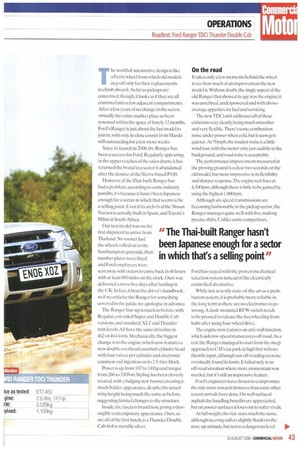HI HO SILVER!
Page 42

Page 43

Page 44

If you've noticed an error in this article please click here to report it so we can fix it.
Ford's Ranger is the latest pickup to get the revamp treatment. We test one example that's so new, you can practically smell the Thai pineapple plantation where it was built
The world of automotive design is like a Ferris wheel from which old models step off only for their replacements to climb aboard. As far as pickups are concerned, though, it looks as if they are all crammed into a few adjacent compartments. After a few years of no change in the sector, virtually the entire market place as been renewed within the space of barely 12 months. Ford's Ranger is just about the last model to join in, with only its close cousin from Mazda still outstanding for a few more weeks.
Since its launch in 2000, the Ranger has been a success for Ford. Regularly appearing in the upper reaches of the sales charts, it has returned the brand to a sector it abandoned after the demise of the Sierra-based P100.
However, if the Thai-built Ranger has had a problem, according to some industry pundits, it's because it hasn't been Japanese enough for a sector in which that seems to be a selling point. Even if its arch rival the Nissan Navara is actually built in Spain, and Toyota's Hilux in South Africa.
Our test model was on the first shipment to arrive from Thai land. No sooner had the wheels rolled on to the Southampton quayside, than number plates were fitted and Ford employees were sent away with orders to come back in 48 hours with at least 800 miles on the clock. Ours was delivered a mere five days after landing in the UK. In fact, it beat the driver's handbook, so if we criticise the Ranger for something covered in the guide, we apologise in advance.
The Ranger line-up is much as before, with Regular, extended Super and Double Cab versions, and standard, XLT and Thunder trim levels. All have the same drive line in 4x2 or 4x4 form. Mechanically, the biggest change is to the engine, which now features a new double overhead camshaft cylinder head with four valves per cylinder and electronic common-rail injection on its 2.5-litre block.
Power is up from 107 to 141hp and torque from 26610 330Nm. Styling has been cleverly treated, with a bulging new bonnet creating a much bolder appearance. despite the actual wing height being much the same as before, suggesting limited changes to the structure.
Inside, the fascia is brand new, giving a thoroughly contemporary appearance. Ours, as are all of the first batch, is a Thunder Double Cab 4x4 in metallic silver.
On the road It takes only a few moments behind the wheel to see how much of an improvement the new model is. Without doubt.the single aspect of the old Ranger that showed its age was the engine; it was unrefined, underpowered and with aboveaverage appetites for fuel and servicing.
The newTDCi unit addresses all of these criticisms very clearly, being much smoother and very flexible. There's some combustion noise under power when cold, but it soon gets quieter. At 70mph, the loudest noise is a little wind roar, with the motor only just audible in the background, and road noise is acceptable.
The pertormance improvement measured at the proving ground is a clear two seconds on the old model, hut more impressive is its flexibility and sharper response.The engine red-lines at 4,50Orpm, although there is little to be gained by using the highest 1,(10Orpm.
Although six-speed transmissions are becoming fashionable in the pickup sector, the Ranger manages quite well with five, making precise shifts. Unlike some competitors, Ford has stayed with the proven mechanical selection system instead of the electrically controlled alternative.
While not as sexily state-of-the-art as a pushbutton system, it is probably more reliable in the long term as there are no electronics to go wrong. A dash-mounted RFW switch needs to be pressed to release the freewheeling front hubs after using four-wheel drive.
The engine now features an anti-stall function, which aids low-speed manoeuvres off-road.As a test, the Ranger managed to start from the steep approach to CM's car park in high first with no throttle input, although our off-roading exercise eventually found its limits. It failed only in an off-road situation where more momentum was needed, but it's still an impressive feature.
Ford's engineers have chosen to compromise the ride more towards firmness than some other recent arrivals have done. On well surfaced asphalt the handling benefits are appreciated, but on poorer surfaces it loses out to softer rivals.
At full weight, the ride stays much the same, although steering suffers slightly thanks to the nose-up attitude, but not to a dangerous level. One downside of the firm settings is that, in twowheel drive, the extra torque makes traction even more of a challenge than before.
Even negotiating a tight roundabout with restraint is likely to produce a squeal from the tyres in dry conditions,whi lea heavy foot on a greasy road could easily result in the view rotating rapidly. We'd like to see traction control available, at least as an option.
Steering is precise,and there is little body roll. but the turning circle is slightly disappointing. with mini-roundabouts and multi-storey car parks still requiring a bit of forethought.
The brakes have been uprated with twinpiston calipers and slightly thicker discs; they work effectively with the well calibrated ABS. Shame about the retention of the dashmounted umbrella-handle parking brake, though. While it does the job at a stretch, it is the sole survivor from a bygone age.
























































































































































































